Article and all photos by Joe Mock, BaseballParks.com
All rights reserved
Throughout America’s history, transportation has been a critical factor in the emergence and growth of communities. No transportation meant no town. Great transportation – be it stage coaches, cattle-drive trails, trains or cars – creates thriving communities.
Take Cleburne, Texas. It was an important hub for the Santa Fe Railway a century ago, which made sense because the town was situated on the Chisholm Trail. That trail was a super highway for cattle drives, as an estimated 5,000,000 head of cattle were pushed northward on it from Texas to Kansas during the late 1800s.
| Ballpark Stats |
 |
| Team: Cleburne Railroaders of the independent American Association |
| First game: May 18, 2017, a 5-3 loss to the Winnipeg Goldeyes |
| Capacity: 4,200, including 1,740 fixed seats and space for 1,044 on bleachers |
| Dimensions: LF – 335; LCF – 372; CF – 400; RCF – 370; RF – 320 |
| Architect: Populous |
| Construction: Hunt |
| Price: $20.7 million, not including the land |
| Home dugout: 3B side |
| Field points: Northeast |
| Playing surface: Astroturf Diamond Series by SCG Fields |
| Ticket info: railroaderbaseball.com/tickets or call 817-945-8705 |
| Betcha didn’t know: Fans in the Dugout Suite utilize the same tunnel under the stands as the players |
If you fast forward to the present, you’ll encounter a new trail with a similar name. The Chisholm Trail Parkway is a limited-access toll road that opened in 2014. The $1.4 billion highway stretches 27 miles, connecting downtown Fort Worth with the northern edge of Cleburne. This roughly follows the original path of the earlier cattle drives.
The parkway has quickly become a godsend for commuters traveling to the business district of Fort Worth from the southern suburbs.
What does this have to do with baseball? Plenty.
Because of Cleburne’s reputation as a railroad town, its baseball team in the Texas League at the turn of the last century was known as, of course, the Railroaders. The 1906 team, featuring future Hall Of Famer Tris Speaker, won the league. The 18-year-old phenom hailed from nearby Hubbard, Texas.
Unfortunately, the franchise folded following that stellar season.
When the new toll road opened in 2014, the mayor of Cleburne was struck with a thought: why couldn’t a new baseball stadium at the terminus of that highway act as a “gateway” to his town, drawing fans from all around the Dallas/Fort Worth area? That ballpark could anchor commercial development, further attracting people and dollars to his community.
On May 18, 2017, Mayor Scott Cain’s dream became a reality, as a shiny new ballpark opened its doors, welcoming pro baseball back to town. And the name of the expansion team in the independent American Association? The Cleburne Railroaders.
Many baseball fans in the Dallas/Fort Worth area are familiar with the Fort Worth Cats, who operated in no fewer than five different independent leagues from 2001 through 2014. Older fans will recall that this team used the same nickname as a storied Minor League franchise that played in Fort Worth from the late 1800s until disbanding in 1964.
| The Railroaders’ conductor |
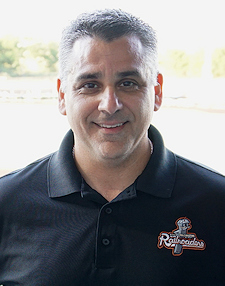 |
| Robbie Fenyes is the team’s president. While working in “supply chain logistics and global economies,” he coached baseball. That led to a stint in the front office of the Texas Rangers before joining the indy Fort Worth Cats. When that franchise folded, he fielded a call from the mayor of Cleburne. That started the ball rolling for what became the Railroaders. |
But the indy team had a fair measure of success, winning its league championship three times. Because the Railroaders emerged just a couple of years after the Cats stopped playing, many fans assumed Cleburne’s team was a continuation of the one in nearby Fort Worth.
“One of the biggest misnomers we’ve had to battle in the 18-month development of this team is that the Fort Worth Cats became the Railroaders,” Robbie Fenyes, the energetic president of Cleburne’s new team, told BaseballParks.com. Interestingly, he also worked in the front office of the Cats. “Literally, the day we were locking the doors (in Fort Worth), Mayor Cain called us and said, ‘Boy, we’d like to talk about baseball in Cleburne.’”
When they met, Fenyes told Cain that “due to the baggage, you don’t want the Cats, so this needs to be a brand-new baseball team.”
Mayor Cain’s vision was for “more than just baseball,” Fenyes recalls. “He wanted to invigorate his community with mixed-use development, and baseball was the first step.”
When the project was put before local voters in November 2015, the $25-million bond package passed overwhelmingly.
Because of Fenyes’ familiarity with the American Association, he set out to convince the league that baseball would be a success in Cleburne. The new tollway was the key. “Cleburne is 30,000 people, and we weren’t going to sell them on that. With the tollway, though, 690,000 people are within 15 minutes of here.” Officials with the league agreed to bring Cleburne on board.
“So baseball is here because of the vision of the Mayor and the toll road,” he concluded.
Fenyes acknowledged that the early stages of designing the park were rocky, and the first architects hired to do it were eventually fired. The City then went through an RFP (Request For Proposal) process to find a new one, and an interesting name emerged. Populous, designers of Olympic, World Cup and Major League stadiums, threw their hat in the ring to design what, for them, was a very small project.
“Populous looked at this and said, ‘Yeah, maybe this is unorthodox for us, but we think this is something we can incorporate into what we do.’ I think they wanted to stretch their wings and see if they could do something small like this,” Fenyes recalled.
 |
| Not long ago, this was a turnip field. Now it’s been graded for an ambitious commercial area to be called Cleburne Station. The first step in this development is the ballpark, seen in the distance here. |
At the time, Populous was also designing the $672-million SunTrust Park for the Braves. The budget for Cleburne’s facility was just $25 million – and that included money to acquire the land. “The scale and magnitude of a Major League ballpark and Minor League are certainly different, but you start each project the same way — by finding out what is most important to the client,” said Aaron Noll, the Project Architect at Populous. “Each project has unique circumstances and goals even though they all revolve around the game of baseball. ”
Because of the team’s nickname, it made sense for its ballpark to be called The Depot (since the development around it is Cleburne Station, it is sometimes referred to as The Depot at Cleburne Station). Naturally, the facility has a railroad theme.
“The architecture needed to reflect the unique history of the city and the Railroaders team that won a championship in 1906,” Noll noted. “This project focused on bringing that history into the ballpark.”
He added that “train replicas were set into the ballpark (and) the steel arched trusses along the main concourse reflect the architecture in historic train stations.”
Indeed, you almost feel that you’re entering a train station of yesteryear when you approach the entry plaza of The Depot.
  |
| The railroad theme of the ballpark is unmistakable, from the full-size facsimile train cars to the arches inside and out. The team has gone all out with its promotions and attractions, such as a skywriting bi-plane that flew over the field prior to the game on Memorial Day. |
Once inside, fans are enjoying the open concourses and intimate seating bowl. There’s a well-stocked merchandise store featuring apparel with the cute rail-road-spike logo. You can also enjoy an air-conditioned museum showing uniforms and mementos from Cleburne’s baseball history.
Taking your family to a game won’t break the bank, as tickets range from $6 for general admission to $12 for box seats behind the plate. Parking is free.
The upper deck is lovely, with attractive and spacious suites and a press box where it should be: on the upper level behind home plate (are you listening, Hartford?). Perhaps the most striking design element, though, is right behind the home on-deck circle.
Fenyes wanted a special seating area where fans – especially young ones – could get a taste of what the players see while they’re watching the game. The result was the Dugout Suite, which is actually under the same concrete roof as the home dugout. “It was envisioned as a place for little league teams to sit in the dugout next to their heroes during the game,” Noll explained. “The view is a vantage point that is typically only shared between players and coaches, but giving it to the fans and specifically the younger ones was a way to engage the fans in their ballpark.”
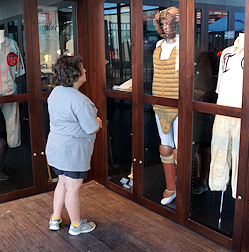 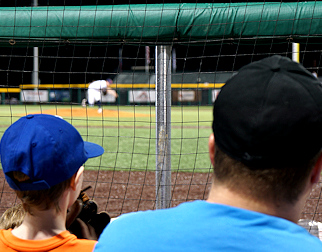 |
| Two outstanding, unique features of The Depot are a museum of well-exhibited baseball mementos from the past (being viewed by Denise Jones of Cleburne) and the Dugout Suite, which provides a stunning view of the action while placing you under the same roof as (and just a few feet away from) the players. |
And you could certainly consider the fans “engaged.” Fenyes revealed that season tickets “have been sold out for about four months, and many of those are three-year deals.” There are four luxury suites that are sold for $20,000 a year, and there are commitments on all of them for the next three years.
So early results are strong. And because of clever planning by Populous, more seating sections can be added on the berms and additional luxury suites can be constructed at the ends of the upper deck if demand dictates. Mayor Cain adds that several changes are already planned for 2018, including the addition of two more railroad cars that will house luxury suites inside. He noted that the City “just ran out of funding” before those cars could be added for the inaugural season of the park.
| Spike |
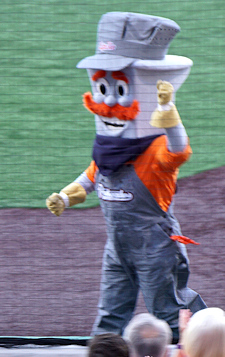 |
| The Railroaders’ logo and mascot were both the result of community involvement. Cleburne firefighter J.J. Lillagore submitted the winning entry for the team’s logo and Cowan Costumes of Cleburne created the outfit for the mascot — named, of course, Spike. You can forgive the Round Rock Express if they are a little annoyed, because their railyard-dog mascot has been named Spike since the team’s inception in 2000. |
Construction of the businesses that will surround the park hasn’t begun yet, but the land is cleared. “The retail part is a five- to seven-year plan, which is smart,” says Fenyes. Already in the works is a hotel that will be beyond CF and movie theaters beyond LF. Restaurants and stores are planned for the land behind the park.
He noted that the retail developer has been greatly encouraged by the success of the baseball team and the events like soccer and college tournaments that are booked for the facility. This could hasten the timetable for the hotel and other businesses.
Fenyes is certainly pleased with the facility and the way the community has embraced the Railroaders. But he’s quick to point out other sources for his pride.
First, operating the franchise is a family affair. Not only does Fenyes’ wife work with the food-service vendor Sedona, his father is the team’s VP of Business Operations. “Anything I’ve learned in this business I learned from my Dad.” Fenyes noted that his father emigrated from Hungary to the U.S. as a child and learned to love baseball. Later he was one of the five founders of Allegiant Airlines. “Because he’d made a career filling airplane seats, after he retired I asked him to come here and fill some baseball seats.”
Fenyes is also quite proud of two of his “whimsical ideas,” as he calls them. One involves the number of fixed seats in the stadium. He explained that at an early meeting with the City, Populous and Hunt, the builders – a meeting where he felt he “wasn’t qualified to be in the room” – there was much disagreement about the proper seating capacity. “Suddenly, everyone looked at me. Well, my (favorite) number has always been 17. It was my uniform number. It’s in my telephone number. So I blurted out ‘I think it should be 1,700 fixed seats!’
“Well, the Populous guys looked at the Hunt guys who looked at the City people, and they said, ‘That would work and that would fit the budget. Let’s do 1,700!’ Today we have 1,740 fixed seats based on a silly idea by me.”
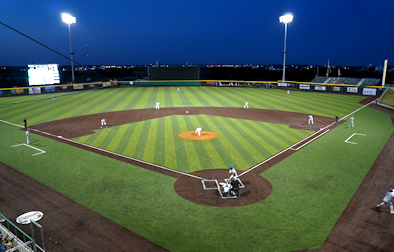
Another ingenious thought by Fenyes is the start time for Railroaders’ games, which is the rather odd time of 7:06 p.m. “It hit me one day that the last great team of the Cleburne Railroaders was the 1906 team with Tris Speaker,” he explained. “Well, ‘1906’ in military time is 7:06 (p.m.), so I called the league office and asked if they’d mind if our first-pitch would be 7:06. After they asked ‘Why?’ and I explained, they said ‘Great idea!’”
Then invoking the name of arguably the greatest promoter in baseball history, Fenyes observed, “I was probably Bill Veeck in another life.”
Considering the success of the launch of his Railroaders and their ballpark, he might not be far off from being this generation’s Bill Veeck.
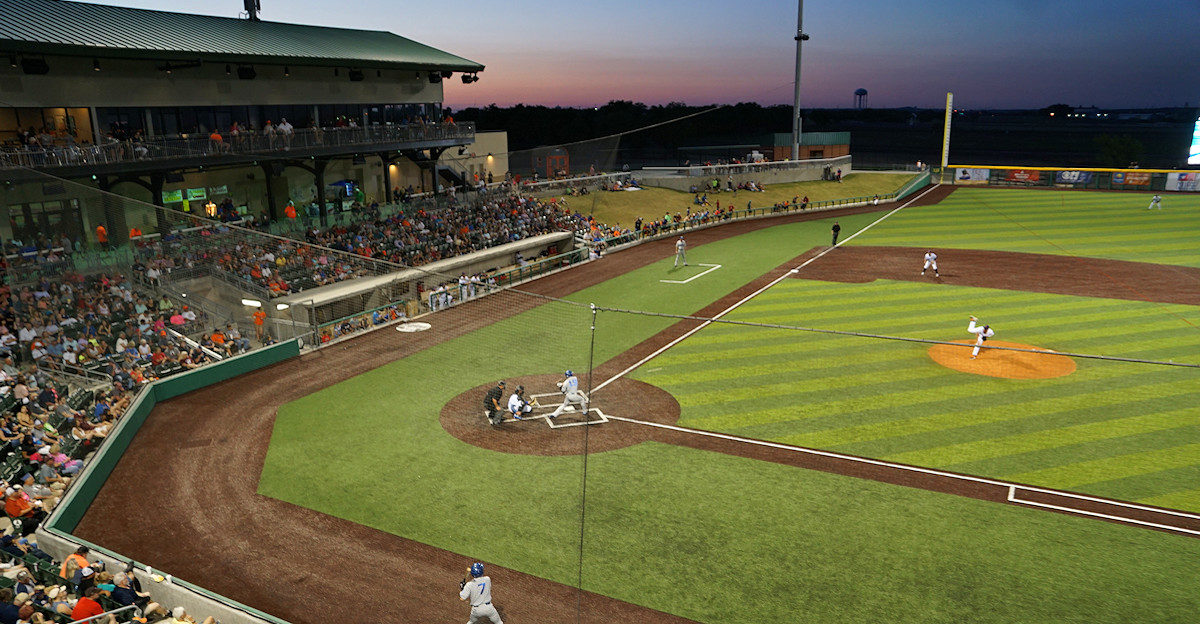
Excellent article and hopefully the team will be a great success. It certainly seems as if the commercial development and hotel could be modeled after the Frisco ballpark but on a smaller scale.
Great article, Joe. It was a joy building the stadium and working to create a special environment that enhances the fans’ experience while preserving our history. On a side note, we have several features that will be added over the next few years (budget constraints limited what we could do in year one). Keep writing about America’s parks so we can all enjoy the beauty of America’s pastime through your eyes! — Scott Cain, Cleburne Mayor
Mayor Cain, thanks for your kind words and for taking the time to comment. Thanks most of all for your dedication to the sport and for going the extra mile to get this ballpark done. It’s something your community will be proud of for years and years to come.
Awesome article and the most surprising thing is how many people are turning out for the FC Cleburne soccer team! I have gone to two of the three games and it’s an amazing atmosphere!
Joe, excellent article about the newest venue in Independent League baseball. Cleburne is very proud of The Depot, and when the surrounding property is fully developed, the taxpayers gamble to pass the bond will pay off. I’m counting in it.
Cleburne, small town with a Big Game.
I was finally able to get to a game recently and I am so very impressed with what has been created for us here in Johnson County. The collaboration of the team to celebrate people/missions connects to the community through special nights and fundraising to support local projects is absolutely perfect. I went on Alex Wilson night, he is a client and friend of mine. The night set up to honor him was planned and handled perfectly by the Railroaders! Congrats to the CLEBURNE Railroaders Team and management, as well as our visionary Mayor Scott Cain who all represent our community in a spectacular way!
As I understand it, the park was designed to be expanded should the Texas League come calling. Certainly plenty of room to add seats on the berms and beyond the outfield fences. One hears rumors of Frisco getting bumped up to AAA, and if that happens, I have to believe the Rangers would be very interested in keeping their AA affiliate close to home.
Frank, yes, that is clever thinking on your part. Lost in all of the hoopla surrounding the triple-play switch of Helena-to-Colorado-Springs-to-San-Antonio-to-Amarillo is the fact that San Antonio City Government isn’t anywhere close to pulling the trigger on building a new park. Nelson Wolfe simply isn’t an adequate park for AAA, so it could very well be that the PCL team ends up elsewhere — like perhaps Frisco or Wichita. Of course, Elmore doesn’t own the RoughRiders, so it might not be easy for Frisco to become Elmore’s PCL team’s landing spot and Chuck Greenberg’s Texas League franchise end up in Cleburne. But stranger things have happened around the Minors!